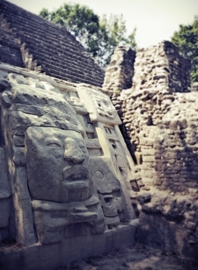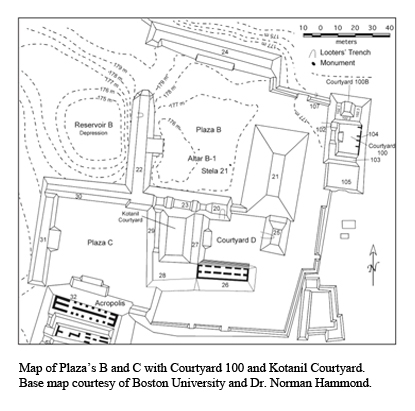
La Milpa, Belize: An Investigation of Courtyard 100 & Kontanil Courtyard
La Milpa, Belize
An Investigation of Courtyard 100 & Kontanil Courtyard.
May 19th, 2011 to June 16th, 2011.
CCI Participants: Dr. Gregory Zaro, Walter Beckwith
Other Collaborators: Dr. Brett Houk, Lindsey Moats & Vincent Sisneros (Texas Tech University)
Funding Support: Dan and Betty Churchill Fund, Getty Archeological Fund & the National Geographic Society.09
“It’s not the occasional fist-sized tarantula that hitches a ride into your tent on your field pack, the ever present threat of scorpions cozying up while you sleep or discovering a coiled fer-de-lance in your boot that can screw up an otherwise pleasant morning…
…It is the howler monkeys.
As one who can appreciate a good prank, I can vouch for the fact that there is nothing quite like being torn from a much needed nights rest by the unearthly roars of these simian alarm clocks hanging in the trees above camp in the early pre-dawn hours…
It’s moments like this that make one realize exactly how far away from home they are.”
– 26 May, 2011
The collapse of the Classic Maya in the ninth century A.D. continues to be one of the most contentious debates in Meso-American archeology. Few events in pre-history have inspired as much misconception within popular culture. Characterized by urban abandonment, the failure of political establishments and large scale, regional depopulation, the Classic Maya collapse represents an exceedingly complex problem. Many variables are likely to blame for this centuries long process, including numerous socio-political and environmental factors – many of which have strong implications on contemporary issues and call for further study.
Excavations at the ancient city of La Milpa in north western Belize were conducted to better define the timeline and examine the conditions surrounding the city’s final years and it’s subsequent abandonment, and by extension, those of the Central Maya Lowlands. Specific attention was paid to the Courtyard 100 and the Kotanil Courtyard complexes in hopes to (a) better understand the construction histories and degree of construction taking place in the city’s final century, (b) recover organic material for radiocarbon analysis to ensure an accurate chronology of the city’s latest occupation and (c) the recovery of artifacts that are indicative of activities taking place in these areas during this critical time.
Courtyard 100 is a small courtyard complex located to the east of Plaza B, La Milpa’s second largest plaza. It is characterized by low mounds to the north and west and a series of low walls defining its eastern margin. A number of units were opened on and around these structures to better define their architecture in relation to the area at large. Additional attention was paid to dense artifact deposits located along the eastern wall of the courtyard. These deposits have yielded a large amount of ceramic, lithic and other artifacts, some of which are diagnostic of elite status as well as a later, terminal classic component of the city. The burial of an infant human was also found below the courtyard along this low walls.
To the south-west of Courtyard 100 lies the nearby Kotanil Courtyard. Structure 28 makes up its southern boundary and was the second focus of excavation. The excavations of Structure 28 were set up largely to determine the area’s construction chronology as well as its condition at the time of abandonment. A staircase on the north side of the structure leading from the courtyard below to the top of the structure, as well as rooms sitting atop the summit of the structure were excavated.From this, multiple construction phases were identified as well as evidence suggesting perhaps a ritual termination of the structure.
“Each day we walk a kilometer or so from the access road through the monumental core of La Milpa to our work areas in the south-east of the site. The trail winds it’s way around a number of large temple structures, ball courts and range buildings, through plazas, into courtyards and overan ancient causeways…
At first look however you’d never know it. Much of what is left of this once bustling city is hidden beneath the tangle of tree roots, vines and dense jungle vegetation. How quickly the forest reclaims what it has had taken.
Upon closer inspection however, features begin to become more apparent — The odd tabular limestone boulder becomes a toppled and eroded stela, occasional flat openings in the forest floor become overgrown plaza surfaces and the exposed cut-stone alignments peeking from beneath the leaf litter become the stairways and tiers of the long abandoned pyramidal structures that have become the hallmark of the ancient Maya… ”
– 2 June, 2011
While much of the analysis of the materials and data recovered from these excavations remains to be done, it is apparent that the activities taking place surrounding La Milpa’s abandonment were much more dynamic and took place much later than previously described. This and the continued research of the area shed light upon this ill-understood event. Funding for this project was graciously provided by the Dan and Betty Churchill Exploration Fund, the Getty Archeological Fund and the National Geographic Society.




